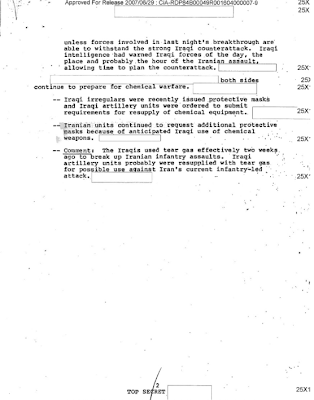In light of the recent use of chemicals in the war in Syria, Foreign Policy has revealed that the United States was, at the very least, complicit in a chemical attack nearly a generation ago.
Back in 1988, American intelligence became aware that the ongoing Iran-Iraq war was not going well for Iraq. Remember, way back then, Iraq was the good guy and Iran was the bad guy! According to CIA documents, the United States had known that Iraqi forces were using chemical weapons as far back as 1982 – 1983 as shown on this document:
…and this document from the CIA posted on the Federation of American Scientists (FAS) website:
Keep in mind that during the years from 1982 to 1984, the battlefield situation for Iraq had become desperate with Iraq in defensive mode and the war had become a dug-in war of attrition. The use of chemicals by Iraq likely came from Saddam Hussein himself; by the mid-1980s, Iraq's total production of chemical weapons including nerve and blister agents was close to 4000 tons.
Interestingly, Tehran Radio had broadcast allegations that Iraq was using chemical weapons as far back as November 1980. By February 1984, Iran's Foreign Ministry announced to the United Nations Conference on Disarmament that Iraq had used chemical weapons at least 49 times in border regions between the two countries killing 109 people and wounding hundreds. Ironically, during the next 31 days, Iraq used chemical weapons an additional 14 times in the Basrah area, wounding another 2200 people. A followup U.N. inspection confirmed that chemicals had been used.
Even the United Nations knew that Iraq was using chemical weapons against Iran as follows:
1. 1983 to 1986: Used in a defensive role; typically to deflect Iranian human-wave assaults. In 1984 Iraq became the first nation to use a nerve agent on the battlefield when it deployed Tabun-filled aerial bombs during the Iran-Iraq war. Some 5,500 Iranians were killed by the nerve agent between March 1984 and March 1985. Tabun kills within minutes. Some 16,000 Iranians were reported killed by the toxic blister agent mustard gas between August 1983 and February 1986.
2. 1986 to early 1988: Iraq adapts use of chemical weapons against Iran to disrupt Iranian offensive preparations.
3. Early 1988 to the conclusion of the war: Iraq integrated large nerve agent strikes into its overall offensive during the spring and summer of 1988 leading to the ceasefire.
As well, the United States was aware that Saddam Hussein had used chemical weapons against Kurdish villages in 1987 and that his forces had used a large-scale poison gas attack on Halabja that killed hundreds to suppress the Kurds who were siding with the Iranians.
Despite all of this evidence, the United States supplied Iraq with intelligence to prevent Iran from exploiting a weakness in Iraqi defences in the the area around the city of Basrah in late 1987 and early 1988. Satellite imagery captured a buildup of Iranian forces that would have resulted in a very large offensive in the spring of 1988. According to Foreign Policy, the U.S. Defense Intelligence Agency was given permission to supply the Iraqis with detailed information on Iranian troop movements, buildups and location of their key facilities. Iraqi forces responded with the use of sarin. While full details of Iranian deaths are not known, the CIA estimates that deaths numbered between hundreds and thousands in each of the four cases where Iraq used chemical weapons in the final stages of the war.
While it is interesting to note America's anger over the probable use of chemical weapons by Syrian forces, it certainly appears that there was complicity in the use of chemicals by a nation that was seen as to be a key ally to American interests in the Middle East nearly thirty years ago.
Click HERE to read more of Glen Asher's columns
You can publish this article on your website as long as you provide a link back to this page.




Be the first to comment